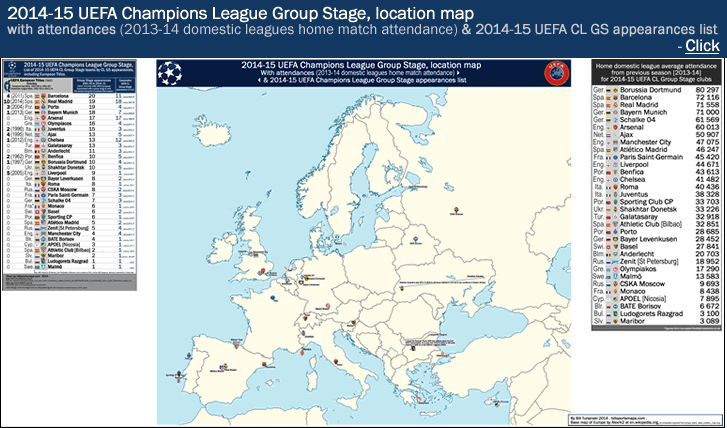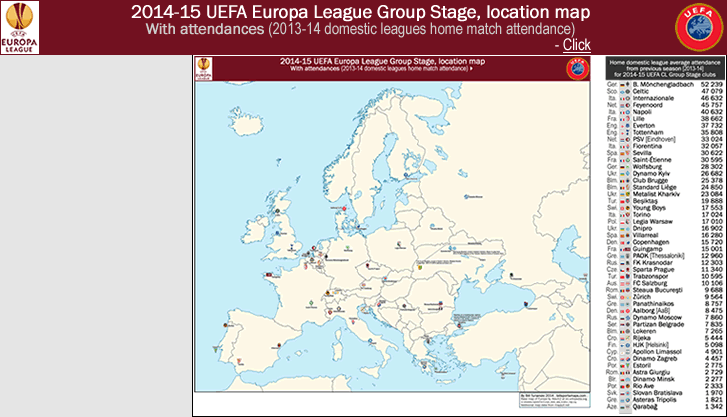
2014–15 UEFA CL GS: location map with attendance data + a chart showing all-time UEFA CL Group Stage appearances for the 32 clubs in the 2014-15 UEFA CL GS
…
…
The 2014-15 Champions League Group Stage appearances list here is a list for the qualified teams this season [2014-15 UEFA Champions League Group Stage/32 teams]. It is shown on the map page and also shown further below. It is similar to the lists I have put together for my CONMEBOL Copa Libertadores posts the last 3 years {such as this one from January 2014, http://billsportsmaps.com/wp-content/uploads/2014/01/2014_copa-libertadores_qualified-teams_all-time_appearances-list_w-titles_c_.gif }. The primary source I used for those Copa Libertadores qualified-teams’-appearances-lists is from the RSSSF.com site; with the list I made here, a page at rsssf.com was instrumental in the way I ended up presenting the data.
The primary source for the data for the chart below is from Number of participating clubs of the Champions League era (en.wikipedia.org).
There is one modification I have added to the list. That modification is also including the first group stage competition that the tournament ever had, in 1991-92 (see next 2 paragraphs). Before I get going trying to explain why it is logical to include the 1991-92 European Cup Group Stage in a Champions League Group Stage all-time list, I will simply point out this…while Wikipedia does not count 1991-92 because it was not called the “Champions League” yet, the RSSSF site does count it, as seen in this list, Champions League – All-Time Table (since 1991/92) (which has not been updated since 2013-14, but which has Barcelona and Manchester United both at 18 appearances at that point [Man U failed to qualify for the CL for this season, so they no longer share the most UEFA CL Group Stage appearances with Barcelona]).
31 countries have sent clubs to this competition’s group stage since its implementation in 1991-92…first as a much smaller group stage of 8 teams in 2 groups (1991-92 and 1992-93 [2 seasons]); then as a 24-team/6 group set-up (from 1993-94 to 1998-99 [6 seasons]), and now since 1999-2000 as a 32 team/8 group format – although for the first 4 seasons in the 32-team format there was actually a second round of a group stage (Second Group Stage existed from 1998-99 to 2002-03). In any event the 32-team/8 groups format has, since 2003-04 been a knockout tournament once that 32-team field is reduced to 16 teams after the group stage. The initial leap from a pure knockout tournament to one with a group stage began in 1991-92, one season before the name-change (from European Cup to Champions League). 8 teams in 2 groups was tried out both in 1991-92, when it was called for that one season the 1991–92 European Cup Group Stage, and then also in 1992-93 the same 8 team/2 group format was used, with the only difference being that in 1992-93 this phase of the tournament was called the “Champions League” for the first time and the Champions League starred-ball logo made its debut. {See this, 1992–93 UEFA Champions League).
This might be the 23rd season with the name “Champions League” and the starred-ball CL logo, but in the list below I am including that first trial-season of the group stage in 1991-92…because it doesn’t make sense not to. True, the 91/92 competition (which had 32 teams in it) did not have the 8-team preliminary round that the 1992-93 Champions League had the following year (which had 36 teams in it, including 8 in the preliminary round, with none of those teams advancing to the 92/93 CL group Stage). But that is the only difference. Once the competition got to the First Stage (32 teams) and Second Stage (16 teams) in both 91/92 and 92/93, the formats were exactly the same.
The 91/92 European Cup Group Stage and the 92/93 Champions League Group Stage had the exact same format, the only difference being the name. So basically, by saying that the Champions League Group Stage as an entity started in 1992-93 – when the tournament was re-named (and when Marseille won it) – is illogical, and insists that brand names trump facts, because the same tournament format was used the year before in 1991-92, when the group stage was called the “European Cup Group Stage” (and when Barcelona won the European title for the first time in their history, beating Sampdoria 1-0 in aet with a goal by Ronald Koeman).
And you know, UEFA, on its website, includes that first-of-the-two much-smaller-seasons of the group stage (8 teams instead of 32 teams) of 1991-92 in its statistics. An example of that is the UEFA site saying this season [2014-15] is Barcelona’s record overall 24th CL appearance instead of its 23rd appearance. On the UEFA site that 24 figure also includes the qualification seasons that Barcelona made it to the early qualifying rounds but then lost out before reaching the group stage, as Barcelona did in the 1992-93 CL qualifying, as well as in the 1995-96 CL qualifying, in the 1996-97 CL qualifying and in the 2003-04 CL qualifying. {See this, FC Barcelona (scroll down right-hand sidebar to “Club record in UEFA competitions”, and you find “Appearances in UEFA Champions League: 24″).
Again, that 24 number counts the seasons (4 seasons) when Barcelona did not qualify for the CL Group Stage, and exited in the CL qualifiers. [77 teams qualified for 2014-15 CL qualifiers.]
I say all this because counting the first group stage of this competition, the Group Stage of 1991-92, as the first CL group stage (which UEFA does [in its statistics at least] and which the RSSF organization does) is why Barcelona are at the top of the list below. That is also why 2 other clubs on the list below have 1 more group stage appearance than on the Wikipedia list linked to at the top of this post. They are Anderlecht and Benfica, who along with Dynamo Kyiv, Panathinaikos, Red Star Belgrade, Sampodoria and Sparta Prague, as well as the winners that season, Barcelona, comprised the 1991–92 European Cup Group Stage. The prototype Champions League season, as it were.
…
Spain has sent the most clubs to the UEFA CL Group Stage – 13 clubs sent to the competition in the 24 seasons that a group stage has existed (counting this current season of 2014-15). Germany and France (which includes the Principality of Monaco within the French football league structure) have sent 10 clubs each; while Italy and England have sent 9 clubs each. That is the top five. Sixth best goes to Netherlands, having sent 7 clubs into the tournament’s group stage. Seventh best is a 4-way tie between Belgium, Portugal, Russia and Turkey, at 5 clubs each.
UEFA European titles list (1956 to present), List of European Cup and UEFA Champions League final (en.wikipedia.org).
Below:
chart of all-time UEFA European Cup/Champions League Group Stage appearances for the 32 clubs in the 2014-15 UEFA Champions League Group Stage
{click on image below to place it in a separate page}…

Sources of data for list above –
Number of participating clubs of the Champions League era (en.wikipedia.org);
Champions League – All-Time Table (since 1991/92) (rsssf.com).
___
Thanks to Alexrk2 for the blank map of Europe at en.wikipedia.org/wiki/File:Europe_blank_laea_location_map.svg.
Thanks to the contributors at 2014–15 UEFA Champions League/Group Stage (en.wikipedia.org).




